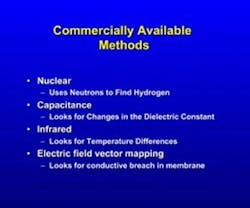My recent column on roof management focused on in-house roof management, where roofing is just one of the many responsibilities that you hold.
In this column, we will take a close look at using an independent roof consultant.
Advantages of Third-Party Consultants
A key argument in favor of hiring an outside expert is that the consultant will hold roofing as a high priority, not in conflict with other responsibilities.
In addition, most roofing decisions are financial in nature. Your upper management will want to look at roofing as an investment, and it should have a satisfactory rate of return as compared to other items. Roof consultants can offer you alternative roofing systems with their estimated cost over a projected life cycle.
Your consultant can organize all the things that the in-house team should have done but had to put off because of higher priorities or lack of technical knowledge. That includes construction documents on what was actually built, not some architectural drawings that were changed as progress was made on the installed system.
When to Enlist Help
Consultants can be drawn into the program at any point. During a design phase, they would work as the owner’s representative, evaluating materials and roofing contractors qualified to meet the design intent. Today, that would certainly look at complying with more stringent energy codes if a re-cover is being contemplated.
During construction, the consultant’s responsibility shifts to verifying that specifications and materials are being followed. This might mean advising the owner if change orders are part of the process. After construction is completed, the consultant will verify that the “punch-list” is completed.PageBreak
New Tools of the Trade
In the recent past, moisture surveys were conducted using three physical methods:
Richard (Dick) L. Fricklas was technical director emeritus of the Roofing Industry Educational Institute prior to his retirement. He is co-author of The Manual of Low Slope Roofing Systems, and continues to participate in seminars for the University of Wisconsin and RCI Inc., the Institute of Roofing, Waterproofing, and Building Envelope Professionals. His honors include the Outstanding Educator Award from RCI, William C. Cullen Award and Walter C. Voss Award from ASTM, the J. A. Piper Award from NRCA, and the James Q. McCawley Award from the MRCA. Dick holds honorary memberships in both ASTM and RCI Inc.
- Infrared Survey: Detects thermal anomalies which may be due to wet insulation.
- Nuclear Survey: Detects anomalies in hydrogen content, which may indicate wet (H2O) materials beneath the membrane.
- Electrical Capacitance: Detects anomalies in an electric field. Considered non-destructive and useful for drywall and many roof systems.
In recent years, electric vector surveys have been added. These do not detect wet insulation but are powerful tools to trace roof leaks.
To these basic tools, a well-equipped roof consultant will add satellite or fly-overs to determine square footage of roof areas and types of roof systems in place. This replaces physically visiting a site, climbing ladders and kicking gravel.
Making destructive test cuts (core cuts) are used to verify the data collected by the above means. Goals of the core cuts include determining how many roof membranes are in place and condition of roof deck, etc. Most building codes limit the roof to two membranes.
The cuts will also determine what the thermal insulation and roof membrane consist of, e.g., bituminous (asphalt or coal-tar pitch), single ply (thermoset or thermoplastic) or sprayed in place polyurethane foam. This basic information is needed is needed for re-cover programs. Doing proper homework would include determining if the roofs under investigation are still under warranty, as unauthorized cuts might void the warranties.
A future column will look at types of contracts available between the owner, consultant, and roofing contractor.
High Energy Prices Affect the Roofing Industry
The higher price of energy affects all building systems, even those that don’t directly consume energy.
Cost-Efficient Roofing Insulation for the Right Thermal Rating
Comply with roofing codes while saving money and energy.
True Sustainability Starts with the Roof
Look past green claims to find the most sustainable roofing system for your facility.
About the Author
Richard L. Fricklas
Richard (Dick) L. Fricklas received a Lifetime Achievement Award and fellowship from RCI in 2014 in recognition of his contributions to educating three generations of roofing professionals. A researcher, author, journalist, and educator, Fricklas retired as technical director emeritus of the Roofing Industry Educational Institute in 1996. He is co-author of The Manual of Low Slope Roofing Systems (now in its fourth edition) and taught roofing seminars at the University of Wisconsin, in addition to helping develop RCI curricula. His honors include the Outstanding Educator Award from RCI, William C. Cullen Award and Walter C. Voss Award from ASTM, the J. A. Piper Award from NRCA, and the James Q. McCawley Award from the MRCA. Dick holds honorary memberships in both ASTM and RCI Inc.

